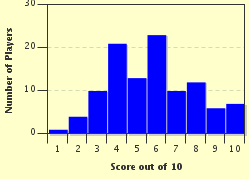Quiz Answer Key and Fun Facts
1. Sieges typically involve a fortification or town being surrounded and cut off from reinforcements and supplies with a view to overrunning it militarily, by deception or through attrition. An early example of a successful military conquest was that of the strongly-fortified city of Lachish by the Assyrian King Sennacharib in 701 BC. What archaeological remains at the site point to the successful strategy?
2. Deception is another tactic that has been used in the past to help overcome a town's defences. There is the story of the wooden horse of Troy, but there was also an antecedent in the conquest of Joppa by the Egyptian general Djehuty in the 15th century BC. Reminiscent of the story of "Ali Baba and the Forty Thieves", how were the attackers spirited into the town?
3. An example of an early form of germ warfare was used during a siege of the Crimean city of Caffa in 1347. Corpses of plague victims from the attacking army were catapulted over the walls which resulted in the city's population succumbing to the disease and thus being easier to overcome. Which aggressor used this tactic?
4. One of techniques typically employed by the aggressor was the military tactic of investment. In such cases the defender's position was completely surrounded to prevent escape or resupply. A famous example of this took place at Alesia in 52 BC when Julius Caesar successfully defeated the besieged Vercingtorix of the Arverni. This resulted in which region falling under Roman rule for the next 500 years?
5. Investing time and energy in building such siege fortifications was ideally best avoided. A negotiated settlement or paying an insider a suitable bribe had many advantages. Psyching out the defenders was another tactic.
During the Achaemenid (or First Persian) Empire, the mountain fortress at Sogdian Rock was considered impregnable. In 327 BC the defenders refused to surrender to the Macedonian aggressors, boasting that men with wings would be required to gain entry. After some 300 attackers scaled the heights overlooking the fortress at night, the defenders were so surprised and demoralised that they capitulated without a fight. Which military leader achieved this coup?
6. Another form of psychological warfare was conducted by the Mongols against the Chinese during the 13th century. The Mongols would arrive at a city and the inhabitants would face a stark choice: surrender immediately and all would be spared; delay and the next phase would result in all men being killed; delay until the final phase meant no lives would be spared. How did the citizens canvas the mood of the Mongols?
7. It was not all doom and gloom for the defenders against the Mongol hordes. The Southern Song Dynasty in China held out against repeated Mongol attacks for 45 years until 1279 because of their use of gunpowder. In which century was gunpowder invented?
8. Mining or sapping is another age-old siege tactic. The idea is to undermine the walls and then collapse the tunnels creating a breach in the walls, which usually results in a rapid conclusion to the siege. It did not always happen this way. During the struggles of the Aetolian League against the Romans, Ambracia came under siege but the defenders discovered the Roman mining activity and used poison gas as a counter-measure. Where are the ruins of Ambracia?
9. The cannon ball changed the dynamics of siege warfare. Thin tall walls were easily overcome and fortifications had to be redesigned to deal with this new threat. Thicker walls and oblique angles helped so siege warfare continued to be important for several centuries. Italian-designed fortresses built in the 16th century proved to be tough to crack, even centuries later. An example is Spandau Citadel located on the outskirts of Berlin. Which army chose to invest and negotiate a surrender of the occupants during the latter stages of World War II rather than storm it?
10. Aeroplanes introduced a new dimension to siege warfare. Two examples of battles with siege-like characteristics in which aircraft played a part are Dien Bien Phu in 1954 and Khe Sanh in 1968, both involving Vietnamese attackers. Who was defending in the 1954 battle?
Source: Author
suomy
This quiz was reviewed by FunTrivia editor
bloomsby before going online.
Any errors found in FunTrivia content are routinely corrected through our feedback system.


